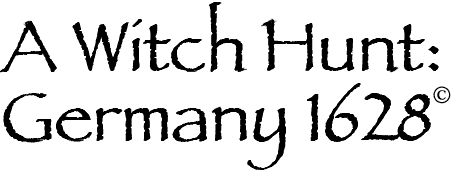HISTORICAL BACKGROUND
Between the years 1400 to 1800 many Europeans thought witches were a serious danger to society. Although, historically and scientifically witches did not really exist, political authorities began to arrest, prosecute and
punish -- or hunt -- people they imagined to be witches. For a general material on the whole issue of the witch hunts, go to the
Witch Hunts main page here, and explore the links. "Ten
Common Errors and Myths about the Witch Hunts" might be particularly
helpful.
In 1628 the Holy Roman Empire was in a fragile condition. What historians would later call the Thirty Years War had rattled through many territories for ten years already. This conflict was fought concerning how much power the emperor would have over other imperial kings, dukes and counts in addition to the clash between Roman Catholicism and Protestantism. Many people had died, territories had been devastated by armies, and political systems weakened. Further, bad weather in the 1620s was causing crop failures, famine and plague. Instead of considering natural causes or the mistakes of politicians, people would blame mysterious witches, in league with the Devil, for these misfortunes. Then, especially in the years 1628-1630, a new wave of witch hunts broke out in the Holy Roman Empire, especially in territories ruled by prince-bishops.
Prince-bishops were both prelates of the church and political rulers. As clerics they administered the possessions and clergy of the Roman Catholic Church within their dioceses. But as princes of the empire, they acted like dukes or counts in their control of taxes, armies, and courts within their individual territories. For more on prince-bishops,
click here.
These clerical/political leaders of territories like Eichstätt, Bamberg, Würzburg, Mainz, or Cologne harshly hunted witches, often by violating civil rights of the accused. Torture could be carried out on hearsay evidence from as few as two witnesses, and contrary evidence by equally valid eyewitnesses could be ignored. Although
imperial legal codes were supposed to prohibit repeated torture, professors and lawyers argued that further bouts of torture were a mere continuation of the first application. Tortured
victims produced fantastic stories and accusations that fed the frenzy of the
hunts.
By about 1630 this wave of persecutions petered out. Many critics had raised voices against the entire practice of hunting witches. Friends of the persecuted had appealed to the emperor and institutions of imperial government like the Imperial court in Speyer or the Diet which in turn called for a halt. And many of the biggest foes of witches simply died. Witch hunts throughout the empire would continue to sporadically break out until the witch laws were revoked in the eighteenth century. Authorities legally executed the last witch in the empire, Anna Maria Schwägelin, in 1775.
|
Bibliography
Primary Sources
313 Bilder aus dem Kriminalmuseum: Ein Rundgang durch die graphische
Abteilung, Medieval Crime Museum, Rothenburg ob der Tauber, 7b.
Heilsbronn, Germany: Druckerei Schulist, 1989.
Behringer, Wolfgang, ed. Hexen und Hexenprozesse in
Deutschland. Munich: Deutscher Taschenbuch Verlag, 2000.
Bilder aus dem Kriminalmuseum, Medieval Crime Museum, Rothenburg ob der
Tauber, 7. Heilsbronn, Germany: Druckerei Schulist, 1989.
Robert Held, Inquisition: a Bilingual Guide to the Exhibition of
Torture
Instruments from the Middle Ages to the Industrial Era. Florence: Qua
d'Arno Publishers, 1985.
Hinckeldey, Christoph, ed. Criminal Justice Through The Ages: from divine judgement to modern German
legislation, John Fosberry, trans. Medieval Crime Museum, Rothenburg ob der
Tauber, 4. Heilsbronn, Germany: Druckerei Schulist, 1981.
"The Prosecutions at Bamberg (1628); The Prosecutions at Würzburg (1628); The Prosecutions at Bonn (1628)," pp. 348-355, in Alan Charles Kors and Edward Peters, and Revised by Edward Peters.
Witchcraft in Europe 400-1700: A Documentary History. 2nd ed. Middle Ages Series. Philadelphia: University of Pennsylvania Press, 2001.
"The Witch Persecutions at Bamberg," pp. 82-88, in E. William
Monter, ed. European Witchcraft, Major Issues in History. New York: John Wiley & Sons, Inc., 1969.
von Spee, Friedrich. Cautio Criminalis oder Rechtliches Bedenken wegen der
Hexenprozesse. Translated by Joachim-Friedrich Ritter. 6th ed. Munich: Deutscher Taschenbuch
Verlag, 2000.
|
|
Secondary Sources
For other good sources for this simulation and on witch hunts in general, click
here.
Pavlac, Brian A. Witch Hunts in the Western World:
Persecution and Punishment from the Inquisition through the Salem Trials.
Westport, CT: Greenwood, 2009.
Behringer, Wolfgang.
Witchcraft Persecutions in Bavaria: Popular Magic, Religious Zealotry and reason of State in Early Modern
Europe. Cambridge, England: Past and Present Publications, 1997.
Merzbacher, Friedrich.
"Torture; Witches and Sorcery," pp. 174-192, in Christoph
Hinckeldey, ed. Criminal Justice Through The Ages: from divine judgement to modern German
legislation, Trans. John Fosberry. Medieval Crime Museum, Rothenburg ob der
Tauber, 4. Heilsbronn, Germany: Druckerei Schulist, 1981.
|
|
Other online simulations of witch hunts:
Di Stefano Productions, "You are accused," http://distefano.com/witch/Trial.htm
[which seems to be dead, try the Internet Archive between 2000 and 2004], sets up a dichotomy of resistance or silence. It has a few good
contemporary graphics and citations of laws, but is otherwise somewhat
sensationalistic.
National Geographic Society, "Salem: Witchcraft Hysteria," http://www.nationalgeographic.com/features/97/salem/,
is graphically beautiful and sophisticated as it conveys an atmosphere of
mystery and fear of that 1692 hunt.
Nix, Dietmar. "A Trial: YOU are the accused!," http://histor.ws/hexen/eng/e-proz.htm,
is rather strident in tone, but usefully detailed about some contemporary
sources and legal arguments of Germany in the 1630s. The picture archive
on the larger site is particularly extensive and interesting.
AZfunnypictures.com, "Witch Hunt," http://www.azfunnypictures.com/witches.html,
is not really a simulation, but a cute arcade-style game, if you want a laugh.
|
A Witch Hunt: Germany 1628 is Copyright © 2004, 2008 by Brian A.
Pavlac. All Rights Reserved. For more information about the site, including credits and sources,
click here.
|
Cite this page as
Pavlac, Brian A. "A Witch Hunt: Germany 1628--Historical
Background."
Prof. Pavlac’s Women’s History Resource
Site. Last Revised 2 May, 2009. URL: <http://departments.kings.edu/womens_history/witch/hunt/whbg.html>. Date Accessed. |


